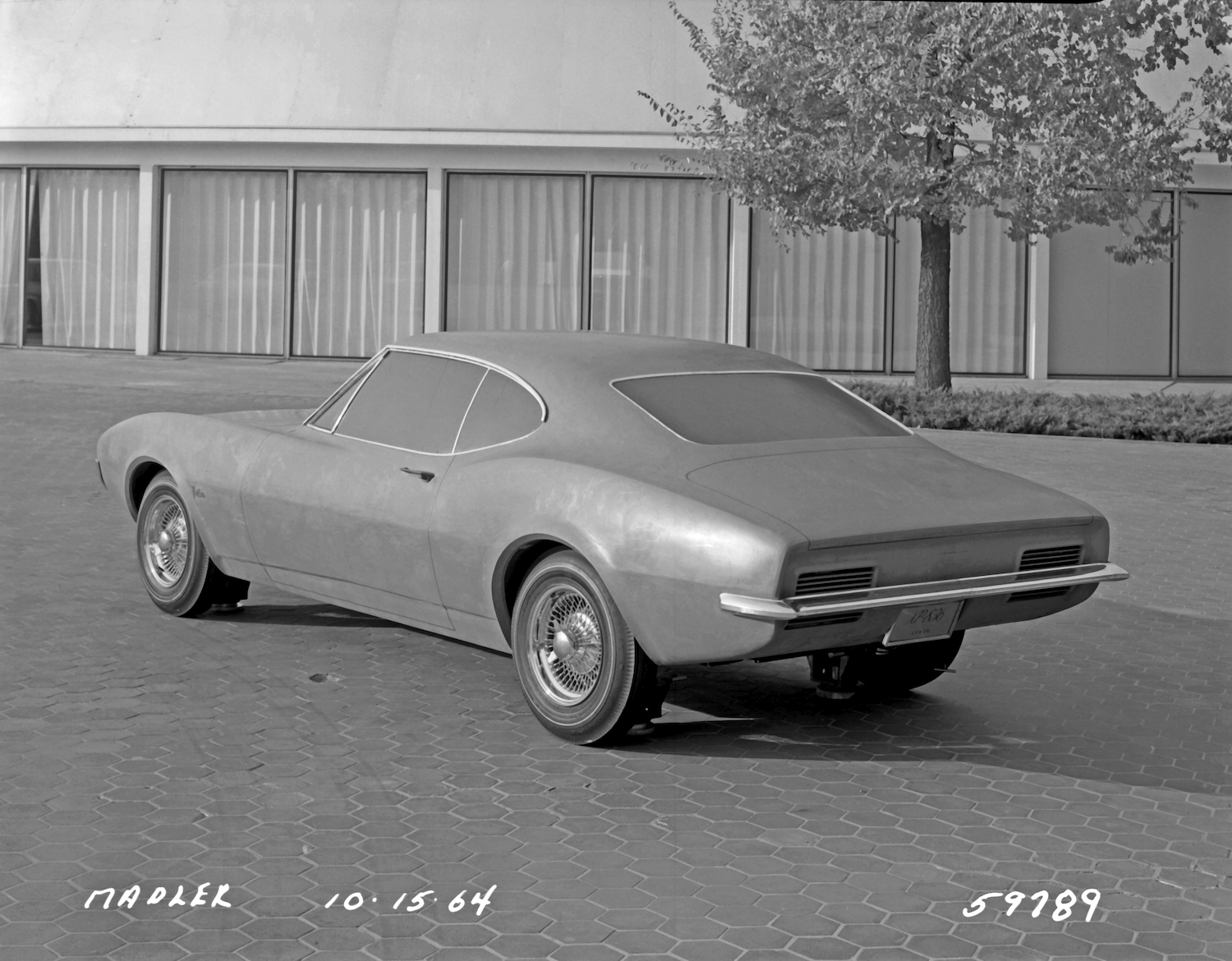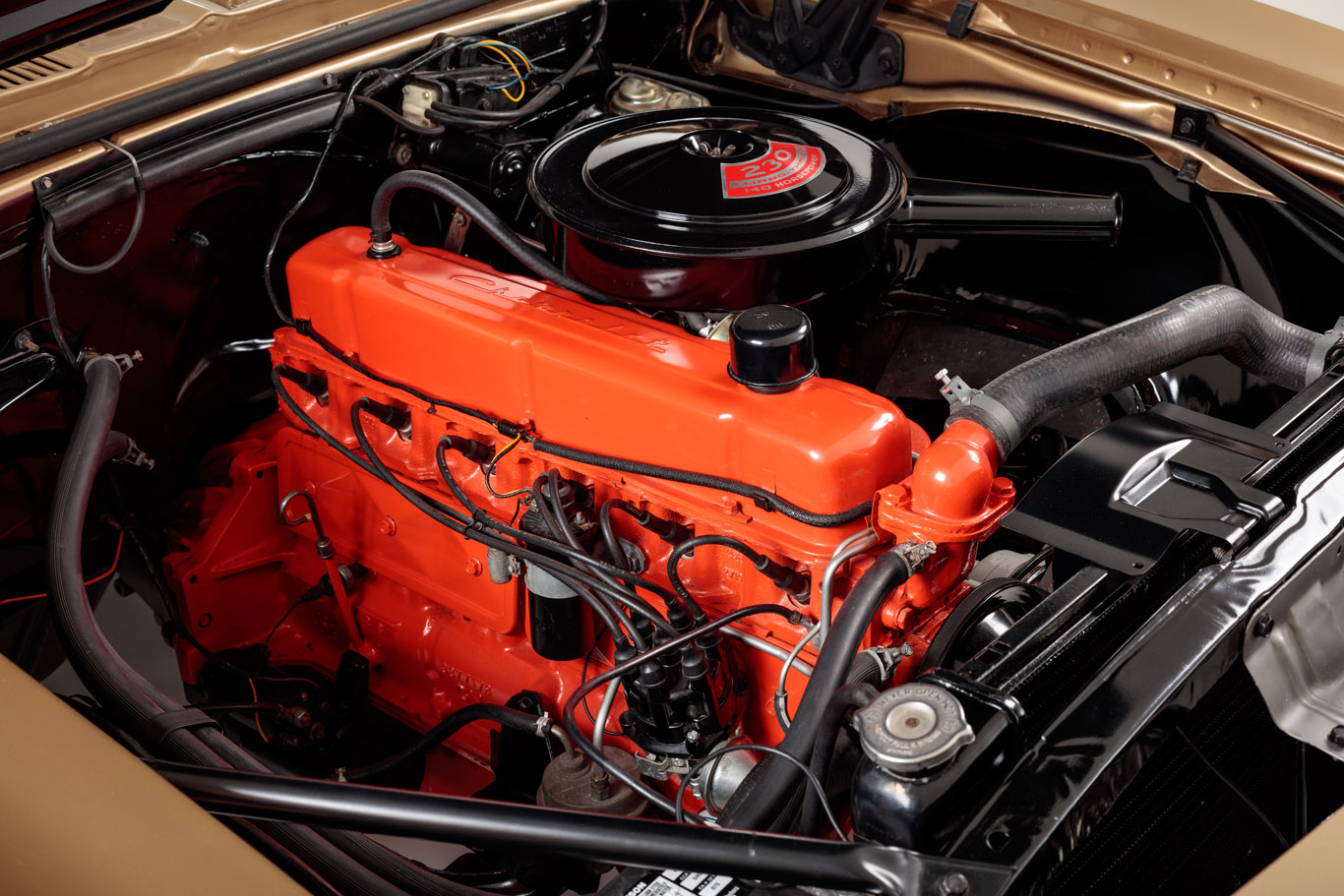How Chevrolet created the Camaro to take on Ford’s Mustang
Few at General Motors or its top-selling Chevrolet Division took the April 17, 1964 public debut of Ford’s ’65 Mustang as a serious threat… at first. That would soon change.
And few inside or outside the company knew that GM designers, as early as mid-1962, had been exploring the exact same idea—a youthful, stylish, compact coupe—at the exact same time when Lee Iacocca and his Ford Division team were creating what would become the Mustang.
Inspired by the elegant ’63 Buick Riviera launching that fall to take on Ford’s Thunderbird “personal coupe,” Chevrolet styling chief Irv Rybicki pondered the idea of doing something similar in concept, though smaller and much more affordable, that could share the new-for-’62 compact Chevy II’s unibody/front-stub-frame platform and mechanicals. When he suggested exploring such a car to vice president of GM Design William L. “Bill” Mitchell, Mitchell was intrigued. He agreed to move forward with it, provided the project’s work took place outside the building where no one would see what they were up to.
Sporty compact concept

“So we went across the street to our warehouse,” Rybicki told us years later, “created a little room there and started a program.” Five months later, they had a Chevy-II-based clay model amazingly close in length, width, and height to the future Mustang—a model that no one outside of Ford knew was being developed. When Rybicki showed it to then-Chevrolet general manager S. E. “Bunkie” Knudsen, Knudsen liked it but chose not to pursue it: “I’ll tell you, fellows,” he said, “the one thing we don’t need right now is another car.”
What were Knudsen’s reservations? Because even General Motors in its 1960s halcyon days of massive profits and worldwide sales (six to seven million units annually) was not about to invest serious time, money, and resources to design, engineer, develop, source, validate, and launch more variations of vehicles than it believed the market would accept in profitable volumes. Chevrolet had launched the radically different rear-engine compact Corvair for 1960, the conventional compact Chevy II for ’62, and the mid-size Malibu for ’64, bringing its passenger-car stable to five distinct lines. It had also relaunched its Corvette sports car as the stunning, space-age Stingray for ’63, and Chevy designers and engineers were already hard at work on major redesigns for Corvair and full-size Chevys for ’65, mid-size Chevelles for ’66, Corvette for ’67 (later delayed to ’68), and Chevy II/Nova compacts for ’68.
Rybicki’s proposed sporty coupe would add a sixth separate Chevy line, and Knudsen didn’t yet see the need. “He was pretty adamant,” Rybicki said, “so we abandoned the project.”
“Super Nova”


Rybicki refused to give up on the sporty coupe idea. Like Iacocca at Ford, he could see America’s emerging youth market coming, so in late 1963, he had Henry “Hank” Haga’s Chevrolet #2 Studio design a sleek Chevy II-based sporty coupe concept they called “Super Nova.” Cleanly sculpted with minimal decorative chrome, it sported a short deck and low profile, a (Mustang-like) long hood, and a sloping rear roof. Mitchell liked it so much that he developed a fiberglass-bodied running car and sent it to the April 4, 1964 New York Auto Show. Its presence there—in apparent production-ready form, two weeks before the Mustang’s scheduled April 17 unveiling at the New York World’s Fair—likely made Ford folks very nervous.
“It was an idea car that was not so exotic that you couldn’t produce it,” said Knudsen, who was then beginning to come around. “I recall some of the Ford people coming over while I was standing there and asking whether we were going to build the car. And I remarked, ‘If they’ll let us, we’ll build it.’ I think that shook ’em up a bit, because it was a pretty good-looking car.”
Rybicki downplayed it as “just a concept piece to see what reaction we’d get from the public… and the reaction was fairly good. I remember Knudsen came back talking about it and wondering how he could sell it [to GM upper management]”. He tried, but then-GM president Jack Gordon said no. “That left us with nothing but the Corvair,” Knudsen lamented.
Mustang debuts to GM yawns

Even when Mustang bowed to thunderous media response and public applause, few at GM took it very seriously. “I remember walking in to view the Mustang the first time we got hold of one,” said then-Chevrolet assistant general sales manager Bob Lund, “and I looked at it and said it would never sell. It seemed too boxy and square—unappealing.”
Then-Pontiac general manager Elliot M. “Pete” Estes had a very different impression: “I happened to be at Design Staff when the first Mustang rolled into the garage,” he recalled. “Everybody was standing around saying what a disaster it was and how market research showed there was no market for it, and so on. I didn’t say anything, but I had a feeling that this thing was going to backfire on us sure as Sam Hill.”
The substantially improved Corvair was soon to debut for ’65 with a nice (somewhat-Corvette-like) new look, and GM brass believed that its optional turbocharged flat-six would help it compete with Ford’s hot-selling new sporty car. Even performance-car-crazy Mitchell was telling everyone who asked that the Corvair Monza was Chevy’s answer to the Mustang. But while they kept their conservative heads in the sand through most of that first summer of Mustang mania, it became increasingly obvious that something more would have to be done. Meanwhile, Rybicki kept Haga’s studio working on sporty coupe concepts, and Knudsen kept trying to sell the idea at monthly Engineering Policy Committee meetings.
Green light
When Mustang sales topped 100,000 in the first four months with no sign of slowing—on its way to the biggest first-year success of any new car in history—his efforts finally paid off. “Some of those people up at the top had some information that the Mustang wasn’t selling very well,” Knudsen said. “They were shocked to pieces when they found out how many had been sold in such short order.”
Some four months into Mustang’s first record-breaking year, GM leaders’ mindset suddenly changed. They decided to counter the Mustang with the small, sporty coupe (and convertible) that would become the 1967 Camaro. The overdue approval came in August 1964, just two years before the Camaro’s planned fall 1966 launch.
The race was on to engineer, design, develop, and build Chevy’s Mustang fighter. “As I remember,” Rybicki said, “the word came down that we would have to beat it in every dimension.” The mandate from the top was to out-gun Mustang in every way—longer, lower, wider, roomier, faster, smoother, better-handling. Yet this hurried-up new entry would have to be built on the (redesigned-for-’68) compact Chevy II/Nova platform and have to use as many off-the-shelf parts as possible to keep its cost down.

Chevy studio chief Haga was far from surprised when program approval finally came: “We had a lot of artwork on the wall,” he later related. “We knew it was going to happen someday because those Mustangs were out there creating a lot of excitement in the marketplace. The people in our studio—designers, modelers, and engineers alike—were all enthusiasts and pretty excited when they found they had a chance to design an all-new four-place sports car to compete directly with the Ford Mustang. It was hot and heavy in our studio once we got the word. We were really flying—did a lot of renderings, put in a lot of overtime!”
Despite his initial skepticism, Lund was thrilled. “We were all highly elated,” he said, “because we just didn’t feel that the Monza could cope with that kind of competition. I remember how we rushed it every chance we got to bring it to market as fast as we could.”
Camaro is born


The “Camaro” name was selected with great difficulty after the internal code name “Panther” and thousands of executive, ad agency, and employee suggestions bombed out; supposedly, Camaro means “warm friend.” Whatever the etymology, the Camaro debuted on September 12, 1966, at a GM Milford Proving Grounds press conference featuring the division’s full 1967 line. “We don’t expect the Camaro to outsell the Mustang immediately,” then-Chevrolet general manager Estes said, “but eventually, it will!”
The car drew mixed reviews when the media later tested it. Popular Mechanics called it “a tidy, handsome and spirited little car that should warm the hearts of all Chevy enthusiasts,” adding that the SS-350 version was “a true dazzler.” Car and Driver, however, criticized its lack of rear-axle control, relatively mild performance and two-speed Powerglide automatic.
Not surprisingly, Chevrolet was not the only U.S. automaker to be inspired by Mustang’s massive market success to launch a competitor. By the time Camaro hit Chevy dealerships, America’s fast-growing ponycar landscape had substantially changed. Partly to appease John DeLorean (who had succeeded Estes as Pontiac general manager and was lobbying hard for a two-seat sports car) internal rival Pontiac countered with its ’67 Firebird on the same platform but with Pontiac powertrains. Ford’s Mercury brand launched its Mustang-based (but more upscale) ’67 Cougar, and Chrysler’s Plymouth Division redesigned its (previously ho-hum) Valiant-based ’64–66 Barracuda coupe and added sharp convertibles and fastbacks for ’67.

The Mustang tallied nearly 500,000 U.S. sales for model year 1965, then (with the addition of a hot-looking fastback) rose to 548,000 for ’66. After that, with four new rivals joining the fray, it scored 443,000 units for ’67, 299,000 for ’68, 293,000 for ’69 and just 170,000 for ’70. The Camaro debuted at just over 200,000 for ’67, then 218,000 for ’68, 194,000 for ’69 and (with a sleek redesign but delayed by a UAW strike) 148,000 for ’70. Firebird averaged 80–110,000 units in those years, topped by Cougar with 100,000–150,000. And Plymouth’s Barracuda, despite its good looks and performance, built only about 62,500 ’67s, then 45,000, 32,000, and 53,000 for ’68, ’69, and ’70.
The Mustang arguably grew too big for ’71, then too small (and Pinto-based) for ’74; but with the AMC Javelin and Dodge Challenger arriving late to the party, it would take six more years for Camaro to out-sell the Mustang (approximately 199,000 to 162,000) for model year ’77.
The epic Camaro vs. Mustang battle raged on through the next 25 years even as sporty coupe and musclecar demand diminished and other contenders fell out, until GM’s Camaro and Firebird were canceled after 2002, leaving the Mustang once more galloping alone. Ford’s pony car (much-improved) marched on with no domestic competition until Camaro was reborn for 2009. Today, both the Camaro and Mustang offer impressive chassis tuning and performance from the base models all the way up to the ZL1 1LE and GT350R, while Dodge’s Challenger is content to ring the muscle car bell with more and more horsepower. Rumors are circulating that the next Camaro may be delayed, but we sincerely hope it’s not ultimately canceled amidst diminishing sales. This pony car rivalry deserves to continue for many years to come.








